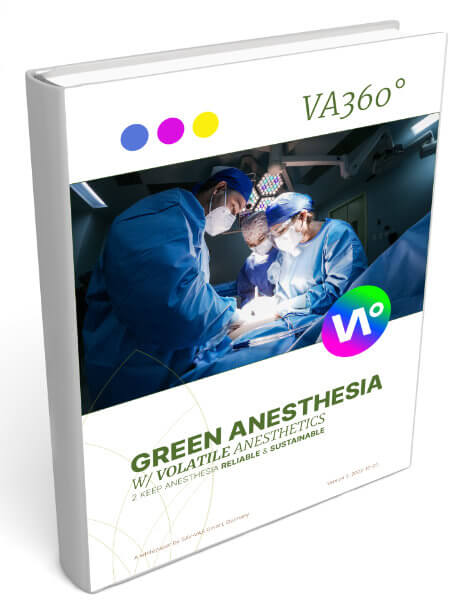Volatile anesthetics have been an integral part of anesthesia for surgical AND specialist procedures
for over 100 years.
Why Volatile Anesthetics?
They can be found in the operating room, in the outpatient setting, but also in office-based specialists or surgery centers outside of the typical hospital setting.
Currently, three agents are predominantly used in Europe as well as in North America: Isoflurane, Sevoflurane, and Desflurane.
In contrast to other anesthesia methods, volatile anesthetics offer significant advantages for the patient but also for the medical staff.
For the patient, the use of anesthetic gases means fast wake-up and recovery times. In the patient’s body, only a fraction of the anesthetic gases are metabolized. This means a much lower burden on the liver and kidneys compared to other hypnotics. Volatile anesthetics further offer organ-protective benefits for the patient.
What’s the problem?
Every drug, including volatile anesthetics, ultimately consists of chemical compounds. The modern gases – Isoflurane, Sevoflurane as well as Desflurane – are chemical substances. If they get into the atmosphere, they can help drive global warming due to their chemical nature. (Global Warming Potential). This is primarily due to the fact that these narcotic gases are halogenated hydrocarbons.
Reference is made to carbon dioxide (CO2) in the calculations of lifetime in the troposphere as well as the calculated potential to contribute to global warming in 20 years.
Sevofluran
Isoflurane
Desflurane
Current pathway of inhalational anesthetics




By discharging anesthetic gases directly into the environment via anesthetic gas extraction (NGA) systems and anesthetic gas delivery systems (AGSS), every hospital involuntarily contributes to global warming every day.
Is this the solution?
Recommendations of german anesthesiologist associations:3
Short-term: Until efficient ways are available to capture anesthetic gases and prevent them from entering the environment, the use of anesthetic gases should be combined with so-called low-flow anesthesia. This reduces the absolute amount of anesthetic gases.
The so-called total intravenous anesthesia (TIVA) is proposed. In a TIVA, analgesics, muscle relaxants as well as the hypnotic are applied directly into the bloodstream. Regional anesthesia is also to be preferred. Both options offer much less emissions due to the procedure itself.
The large-scale use of so-called total intravenous anesthesia (TIVA) should be critically evaluated because of the disadvantages for the patient. The impact of TIVA drugs on the environment is also neither been considered nor scientifically researched.
Medium-term: In order to secure the benefits of volatile anesthetics for patients, surgeons, but also the healthcare systems of countries in the medium term, only one solution can help: Consistent and efficient filtering of anesthetic gases before they enter the environment:
VA360°
VA360 is THE solution
VA360 is a concept for efficient and rational recycling of volatile anesthetics.
The VA360 uses a system that is set up directly on site in the hospital. This facility is not a medical device and operates largely autonomously.
VA360 uses technology to capture Volatile Anesthetics directly at the point of exit from a hospital.
VA360 is resource efficient for medical staff. Doctors, nurses and medical technicians can attend to their primary tasks. VA interception takes place without their use. No valuable hospital resources are tied up.
By intercepting the volatile anesthetics as efficiently as possible, this can be returned to the pharmaceutical manufacturers to be reintroduced into the production process. There, the intercepted anesthetic gases can be processed and recycled. Far fewer new raw materials are needed to produce new anesthetic gas.

Va360 is the
Solution for
Nursing Staff
Physicians
Health Care System
Industry
We provide a whitepaper explaining in detail what the VA360 concept
is all about. Also read how to make your daily routines greener and your work more sustainable.
Download FREE Whitepaper!


Literature
1 ANNEXES to the Proposal for a Regulation of the European Parliament and of the Council on Fluorinated Greenhouse
Gases, Amending Directive (EU) 2019/1937 and Repealing Regulation (EU) No 517/2014“, 2022. https://doi.org/10.5040/9781782258674. Page 7
gases, amending Directive (EU) 2019/1937 and repealing Regulation (EU) No 517/2014 (2022).
https://eur-lex.europa.eu/legal-content/EN/TXT/?uri=celex%3A52022PC0150. Page 39